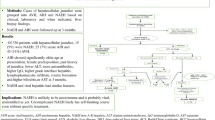Abstract
We evaluated serum hyaluronate (HA) levels in 17 patients with acute hepatitis and 9 with fulminant hepatitis (FH). Upon admission, patients with FH showed increased levels of serum HA and these levels showed significant correlation with biochemical parameters such as human hepatocyte growth factor, hepaplastin test, and prothrombin activity. In patients with AH, the levels of serum HA decreased during convalescence. Higher serum HA levels were observed in patients with type A acute hepatitis than in patients with non-A type. In patients with FH, serum HA levels were decreased in the survivors, while they were elevated in the non-survivors. These findings suggest that serum HA levels may be a useful indicator for evaluating the prognosis of patients with acute and fulminant hepatitis. Further study is necessary to determine whether there is a causal relationship between elevated serum HA levels and the type of hepatitis virus.
Similar content being viewed by others
References
Fraser JRE, Laurent TC, Pertoft H, et al. Plasma clearance, tissue distribution and metabolism of hyaluronic acid injected intravenously in the rabbit. Biochem J 1981;200:415–424.
Eriksson S, Fraser JRE, Laurent TC, et al. Endothelial cells are a site of uptake and degradation of hyaluronic acid in the liver. Exp Cell Res 1983;144:223–228.
Smedsrød B, Pertoft H, Eriksson S, et al. Studies in vitro on the uptake and degradation of sodium hyaluronate in rat liver endothelial cells. Biochem J 1984;223:617–626.
Fraser JRE, Laurent TC, Engström-Laurent A, et al. Elimination of hyaluronic acid from the bloodstream in the human. Clin Exp Pharmacol Physiol 1984;11:17–25.
Fraser JRE, Alcorn D, Laurent TC, et al. Uptake of circulating hyaluronic acid by the rat liver: Cellular localization in situ. Cell Tissue Res 1985;242:505–510.
MacGary CT, Raja RH, Weigel PH. Endocytosis of hyaluronic acid by rat liver endothelial cells. Evidence for receptor recycling. Biochem J 1989;257:875–884.
Lebel L, Fraser JRE, Kimpton WS, et al. A pharmacokinetic model of intravenously administered hyaluronate in sheep. Pharm Res 1989;6:677–682.
Engström-Laurent A, Lööf L, Nyberg A, et al. Increased serum hyaluronate in liver disease. Hepatology 1985;5:638–642.
Frébourg T, Delpech B, Bercoff E, et al. Serum hyaluronate in liver diseases: Study by enzymoimmunological assay. Hepatology 1986;6:392–395.
Nyberg A, Engsröm-Laurent A, Lööf L. Serum hyaluronate in primary biliary cirrhosis. A biochemical marker for progressive damage. Hepatology 1988;8:142–146.
Babbs C, Haboubi NY, Mellor JM, et al. Endothelial cell transformation in primary biliary cirrhosis: A morphological and biochemical study. Hepatology 1991;11:723–729.
Gibson PR, Fraser JRE, Brown TJ, et al. Hemodynamic and liver function predictors of serum hyaluronan in alcoholic liver disease. Hepatology 1992;15:1054–1059.
Ueno T, Inuzuka S, Torimura T, et al. Serum hyaluronate reflects hepatic sinusoidal capillarization. Gastroenterology 1993;105:475–481.
Gibson PR, Fraser JR, Colman JC, et al. Change in serum hyaluroman: A simple index of short-term drug-induced changes in hepatic sinusoidal perfusion. Gastroenterology 1993;105:470–474.
Poupon RE, Balkau B, Guechot J, et al. Predictive factors in ursodeoxycholic acid-treated patients with primary biliary cirrhosis: Role of serum markers of connective tissue. Hepatology 1994;19:635–640.
Adams DH, Hubsher LWSG, Neuberger JM. Hepatic endothelial cells. Targets in liver allograft rejection? Transplantation 1989;47:479–482.
Pollard SG, Forbes MA, Metcalfe SM, et al. Hyaluronic acid in the assessment of liver graft function. Transplantation Proc 1990; 22:2301–2302.
Shimizu H, He W, Guo P, et al. Serum hyaluronate in the assessment of liver endothelial cell function after orthotopic liver transplantation in the rat. Hepatology 1994;20:1323–1329.
Hirata K, Ogata I, Ohta Y, et al. Hepatic sinusoidal cell destruction in the development of intravascular coagulation in acute liver failure of rats. J Pathol 1989;158:157–165.
Fujiwara K, Ogata I, Mochida S, et al. Activated Kupffer cells as a factor of massive hepatic necrosis after liver resection. Hepato-Gastroenterol 1990;37:194–197.
Sato S, Murakami A, Yoshida T, et al. Usefullness of antithrombin III and α2-plasmin inhibitor in early differentiation of fulminant hepatitis and severe form of acute hepatitis. Gastroenterol Jap 1983;18:128–136.
Chichibu K, Matsuura T, Shichijo S, et al. Assay of serum hyaluronic acid in clinical application. Clin Chem Acta 1989; 181:317–324.
Owren PA, Strandli OK. Normotest. Farmakoterapi 1969;25: 14–26.
Quick AJ, Stanley-Brown M, Bancroft FW. A study of the coagulation defect in hemophilia and jaundice. Am J Med Sci 1935;501–511.
Tsubouchi H, Hirono S, Gohda E, et al. Clinical significance of human hepatocyte growth factor in blood from patients with fulminant hepatic failure. Hepatology 1989;9:875–881.
Tsubouchi H, Niitani Y, Hirono S, et al. Levels of the human hepatocyte growth factor in serum of patients with various liver diseases determined by an enzyme-linked immunosorbent assay. Hepatology 1991;13:1–5.
Deaciuc IV, Bagby GJ, Lang CH, et al. Hyaluronic acid uptake by the isolated, perfused rat liver: An index of hepatic sinusoidal endothelial cell function. Hepatology 1993;17:266–272.
Kato A, Sato S, Kurosawa T, et al. Usefulness of plasma methionine in differentiation of fulminant hepatitis from severe form of acute hepatitis (in Japanese). Jpn J Gastroenterology 1983;80:1224.
Jonker A, Dijkhuis FJ, Hardonk MJ, et al. Immunohistochemical study of hepatic fibrosis induced in rats by multiple galactosamine injections. Hepatology 1994;19:775–781.
Nolan JP. The role of endotoxin in liver injury. Gastroenterology 1975;69:1346–1356.
Delamata M, Meager A, Rolando N, et al. Tumor necrosis factor production in fulminant hepatic failure: Relation to aetiology and superimposed microbial infection. Clin Exp Immunol 1990; 82:479–484.
Deaciuc IV, Bagby GJ, Niesman MR, et al. Modulation of hepatic sinusoidal endothelial cell function by Kupffer cells: An example of intracellular communication in the liver. Hepatology 1994;19:464–470.
Author information
Authors and Affiliations
Rights and permissions
About this article
Cite this article
Suzuki, K., Endo, R., Takikawa, Y. et al. Serum hyaluronate in patients with acute and fulminant hepatitis. J Gastroenterol 31, 237–241 (1996). https://doi.org/10.1007/BF02389523
Received:
Accepted:
Issue Date:
DOI: https://doi.org/10.1007/BF02389523



